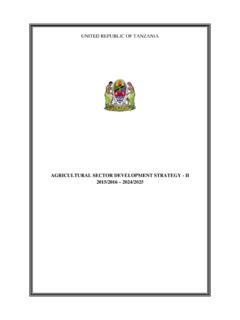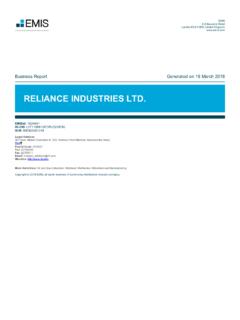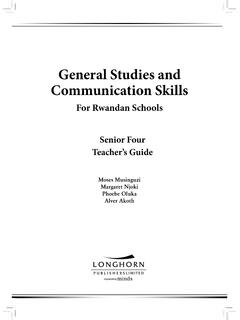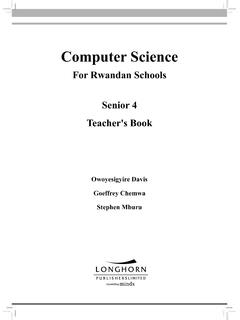Transcription of OECD Due Diligence Guidance for Responsible Supply …
1 Isbn 978-92-64-25238-7 20 2016 02 1 POECD Due Diligence Guidance for Responsible Supply Chains of Minerals from Conflict-Affected and High-Risk AreasTHiRD EDiTiOnContentsRecommendation of the Council on Due Diligence Guidance for Responsible Supply Chains of Minerals from Conflict-Affected and High-Risk AreasOECD Due Diligence Guidance for Responsible Supply Chains of Minerals from Conflict-Affected and High-Risk Areas Supplement on tin, tantalum and tungstenSupplement on goldOECD Due Diligence Guidance for Responsible Supply Chains of Minerals from Conflict-Affected and High-Risk AreasConsult this publication on line at work is published on the OECD iLibrary, which gathers all OECD books.
2 Periodicals and statistical for more Due Diligence Guidance for Responsible Supply Chains of Minerals from Conflict-Affected and High-Risk AreasTHiRD EDiTiOnOECD Due Diligence Guidance for Responsible Supply Chains of Minerals from Conflict-Affected and High-Risk AreasThis document and any map included herein are without prejudice to the status ofor sovereignty over any territory, to the delimitation of international frontiers andboundaries and to the name of any territory, city or 978-92-64-25238-7 (print)ISBN 978-92-64-25247-9 (PDF)Photo credits: Cover to OECD publications may be found on line at: OECD 2016 You can copy, download or print OECD content for your own use, and you can include excerpts from OECD publications, databases and multimedia products in your own documents, presentations, blogs, websites andteaching materials, provided that suitable acknowledgment of OECD as source and copyright owner is requests for public or commercial use and translation rights should be submitted to for permission to photocopy portions of this material for public or commercial use shall be addresseddirectly to the Copyright Clearance Center (CCC)
3 At or the Centre fran ais d exploitation dudroit de copie (CFC) at cite this publication as:OECD (2016), OECD Due Diligence Guidance for Responsible Supply Chains of Minerals from Conflict-Affected and High-Risk Areas: Third Edition, OECD Publishing, DUE Diligence Guidance FOR Responsible Supply CHAINS OF MINERALS FROM OECD 20163 ForewordThe OECD Due Diligence Guidance for Responsible Supply Chains of Mineralsfrom Conflict-Affected and High-Risk Areas ( the Guidance ) is the first exampleof a collaborative government-backed multi-stakeholder initiative on responsiblesupply chain management of minerals from conflict-affected areas.
4 Its objective is tohelp companies respect human rights and avoid contributing to conflict through theirmineral sourcing practices. The Guidance is also intended to cultivate transparentmineral Supply chains and sustainable corporate engagement in the mineral sectorwith a view to enabling countries to benefit from their mineral resources andpreventing the extraction and trade of minerals from becoming a source of conflict,human rights abuses, and insecurity. With its Supplements on Tin, Tantalum,Tungsten and Gold, the OECD Guidance provides companies with a complete packageto source minerals responsibly in order for trade in those minerals to support peace anddevelopment and not Guidance was developed through a multi-stakeholder process with in-depthengagement from OECD and eleven countries of the International Conference on theGreat Lakes Region (Angola, Burundi, Central African Republic, Republic of Congo,Democratic Republic of Congo, Kenya, Rwanda, Sudan, tanzania , Uganda andZambia)
5 , industry, civil society, as well as the United Nations Group of Experts on theDRC. Five multi-stakeholder consultations were held to develop the Guidance and itstwo Supplements, with four in Paris in December 2009 and April 2010 as well as Mayand November 2011. A joint ICGLR-OECD consultation was held in Nairobi inSeptember 2010 where Brazil, Malaysia and South Africa were also represented. As aresult, the Guidance is practically-oriented, with emphasis on collaborative constructiveapproaches to complex United Nations Security Council resolution 1952 (2010) [S/RES/1952(2010)]supported taking forward the due Diligence recommendations contained in the finalreport of the United Nations Group of Experts on the Democratic Republic of the Congo,designed to be consistent with the OECD Due Diligence Guidance has been approved by the OECD Investment Committee and theOECD Development Assistance Committee, and has been endorsed by the elevenmember states of the International Conference on the Great Lakes Region (ICGLR)
6 Inthe Lusaka Declaration, adopted on 15 December DUE Diligence Guidance FOR Responsible Supply CHAINS OF MINERALS FROM OECD 20164An OECD Recommendation on the Due Diligence Guidance was adopted byCouncil at Ministerial level on 25 May 2011, amended on 17 July 2012 to include areference to the Supplement on Gold and again amended on 25 September 2015following approval by the Investment Committee and the Development AssistanceCommittee of changes to the Introduction to the Guidance . While not legally binding,the Recommendation reflects the common position and political commitment of OECD members and non-member third edition of the OECD Due Diligence Guidance for Responsible SupplyChains of Minerals from Conflict-Affected and High-Risk Areas providesclarification on the scope of the Guidance by removing language in the Introduction thatwas perceived to limit its application only to the Supply chains of tin, tantalum, tungstenand gold.
7 The updated edition now clarifies that the Guidance provides a framework fordetailed due Diligence as a basis for Responsible Supply chain management of OF CONTENTSOECD DUE Diligence Guidance FOR Responsible Supply CHAINS OF MINERALS FROM OECD 20165 Table of ContentsRecommendation of the Council on Due Diligence Guidance for Responsible Supply Chains of Minerals from Conflict-Affected and High-Risk Areas ..7 OECD Due Diligence Guidance for Responsible Supply Chains of Minerals from Conflict-Affected and High-Risk Areas..11 Introduction ..12 What is due Diligence in the mineral Supply chain and why is it necessary? ..13 Who should carry out due Diligence ?
8 15 Structure of the Guidance ..16 Nature of the Guidance ..16 Annex Framework for Risk-Based Due Diligence in the Mineral Supply Chain ..17 Annex Supply Chain Policy for a Responsible Global Supply Chain of Minerals from Conflict-Affected and High-Risk Areas..20 Annex Measures for Risk Mitigation and Indicators for Measuring Improvement ..25 Supplement on Tin, Tantalum and Tungsten ..31 Scope and definitions ..32 Red flags triggering the application of this supplement ..33 STEP 1: Establish strong company management systems ..36 STEP 2: Identify and assess risks in the Supply chain..41 STEP 3: Design and implement a strategy to respond to identified risks.
9 44 STEP 4: Carry out independent third-party audit of smelter/refiner s due Diligence practices ..47 STEP 5: Report annually on Supply chain due Diligence .. Note for Upstream Company Risk Assessment ..54 Supplement on Gold ..61 Introduction and scope ..62 Definitions ..65 TABLE OF CONTENTSOECD DUE Diligence Guidance FOR Responsible Supply CHAINS OF MINERALS FROM OECD 20166 STEP 1: Establish strong company management systems ..72 STEP 2: Identify and assess risks in the Supply chain..78 STEP 3: Design and implement a strategy to respond to identified risks99 STEP 4: Carry out independent third-party audit of refiner s duediligence practices.
10 106 STEP 5: Report annually on Supply chain due Diligence .. 111 Appendix Suggested measures to create economic and developmentopportunities for artisanal and small-scale miners .. in the Supply chain of tin, tantalum and tungsten from conflict-affected and high-risk areas .. in the Supply chain of gold from conflict-affected and high-risk areas ..71 RECOMMENDATION OF THE COUNCIL ON DUE Diligence Guidance FOR Responsible DUE Diligence Guidance FOR Responsible Supply CHAINS OF MINERALS FROM OECD 20167 Recommendation of the Council on Due Diligence Guidance for Responsible Supply Chains of Minerals from Conflict-Affected and High-Risk Areas1As amended on 17 July 2012 THE COUNCIL, Having regard to Article 5(b) of the Convention on the Organisation forEconomic Co-operation and Development of 14 December 1960; Having regard to the Guidelines for Multinational Enterprises which formpart of the Declaration on International Investment and MultinationalEnterprises.
















